高中动词时态 与 被动语态
高中英语动词的时态和语态

高中英语动词的时态和语态1、表示在过去某一时间点发生的动作或所处的状态,与现在没有关系。
常用的时间状语有:yesterday, last night, at that time等。
2、表示在过去某一段时间里反复出现的动作或状态,与现在没有关系。
3、用used to do或would do表示过去经常或反复发生的动作。
4、有些情况发生的时间没清楚表明,但实际上是“刚才,刚刚”发生的,属于过去时间,应使用过去时态。
常见的有I didn’t know…或I forgot…等。
5、一般过去时可与today, this week, this month等时间状语连用。
三、一般将来时1、will/shall do(1)表示将来会出现的动作或状态。
常用的时间状语:this evening, tomorrow, next week/month…,at the end of this term, in a few minutes等。
(2)表示将来经常发生的动作。
(3)表示事物的固有属性或必然趋势、倾向。
(4)表示说话过程中做出某种决定。
注意:条件状语从句中的will表示“决心,意愿”,此时will是情态动词表示意愿。
2、be going to do(1)表示已经决定或安排要做的事。
(2)表示根据某种迹象认为在最近或将来将要发生的事。
3、be to do(1)表示约定、计划或按职责、义务要求即将发生的动作。
(2)表示说话人的意志、意图、职责、义务、命令。
(3)表示注定要发生的事情。
4、be about to do(1)表示即将发生的动作,意为“正要,即将”。
(2)不可与表示具体的将来时间的副词或副词性短语连用,但可以同由as或when 引导的时间状语从句连用。
5、某些动词的现在进行时表示即将发生的动作。
四、过去将来时1、would/should do表示从过去某一时间来看将要发生的动作或将要存在的状态。
通常用于其主句的谓语为过去时态的宾语从句中。
高中英语知识点归纳被动语态的构成和用法

高中英语知识点归纳被动语态的构成和用法被动语态是英语语法中常用的一个句子结构,被动语态的构成和用法对于学习英语的学生来说非常重要。
本文将就高中英语知识点归纳被动语态的构成和用法进行详细解析,帮助学生更好地掌握这个语法结构。
一、被动语态的构成被动语态的构成由两部分组成:be动词的各种时态形式和过去分词。
根据主句的时态和语态,be动词的形式会相应发生变化。
1. 现在时态的被动语态构成方式:主动语态:主语 + 动词(to be) + 过去分词被动语态:主语 + am/is/are + 过去分词2. 过去时态的被动语态构成方式:主动语态:主语 + 动词(to be) + 过去分词被动语态:主语 + was/were + 过去分词3. 将来时态的被动语态构成方式:主动语态:主语 + 动词(to be) + going to + 过去分词被动语态:主语 + will be + 过去分词4. 现在完成时态的被动语态构成方式:主动语态:主语 + have/has + 过去分词被动语态:主语 + have/has been + 过去分词二、被动语态的用法被动语态主要用来强调动作的承受者,或表达客观事实,又或者在不知道或想隐瞒动作执行者时使用。
下面将介绍被动语态的常见用法:1. 及物动词的被动语态:及物动词是指需要宾语才能完整表达意思的动词,常见的及物动词有:write, read, eat, drink等。
在被动语态中,及物动词的宾语变成主语,而原来的主语则成为介词"by"引导的短语。
例句:Active: John wrote a letter.(约翰写了一封信。
)Passive: A letter was written by John.(一封信被约翰写了。
)2. 不及物动词的被动语态:不及物动词是指没有宾语的动词,如:arrive, come, go等。
这类动词在被动语态中的主语仍然是动作的承受者,同样需要使用be动词的相应时态形式和过去分词构成。
动词的语态和时态的区别与用法

动词的语态和时态的区别与用法动词是语言中最重要的组成部分之一,它们描述了动作、状态或事件的发生和发展。
在语法中,动词分为不同的语态和时态,这些语态和时态有着不同的用法和含义。
本文将详细介绍动词的语态和时态的区别以及它们的正确用法。
一、动词的语态1. 主动语态主动语态是指主语是动作的执行者,它强调主体的主动性和行动能力。
在主动语态中,动词直接表示动作的发出。
举例:- The boy kicked the ball.(这个男孩踢了球。
)- She wrote a letter.(她写了一封信。
)- He paints a picture.(他正在画一幅画。
)2. 被动语态被动语态是指主语是动作的接受者或承受者,它强调动作对主体的影响或是由外界施加给主体。
在被动语态中,动词通常由 "be" 加以变化,并在后面加上动作的执行者。
举例:- The ball was kicked by the boy.(球被男孩踢了。
)- A letter was written by her.(一封信被她写了。
)- The picture is being painted by him.(这幅画正在被他画。
)被动语态多用于强调动作的接受者或者主体的无法执行动作的情况。
二、动词的时态1. 现在时现在时态用于表示目前正在进行或经常发生的动作、状态或事件。
举例:- I go to school every day.(我每天去学校。
)- She is reading a book now.(她现在在读一本书。
)- They often play football on weekends.(他们经常在周末踢足球。
)2. 过去时过去时态用于表示已经发生或已经结束的动作、状态或事件。
举例:- I went to the park yesterday.(我昨天去了公园。
)- He studied in the library for three hours.(他在图书馆学习了三个小时。
关于高二的动词被动语态知识点总结
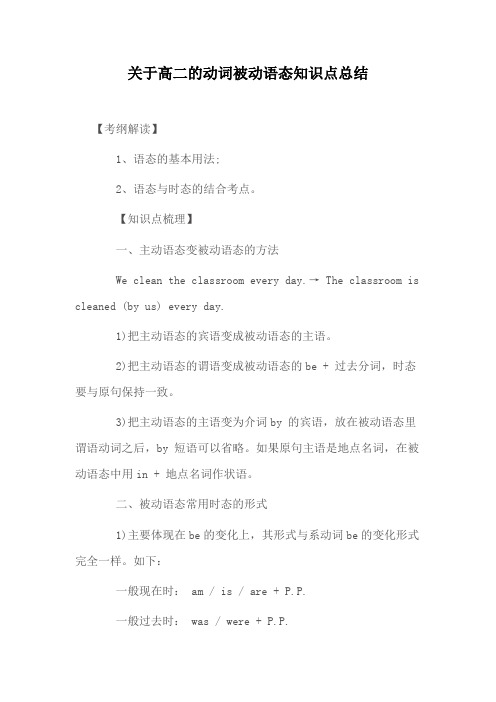
关于高二的动词被动语态知识点总结【考纲解读】1、语态的基本用法;2、语态与时态的结合考点。
【知识点梳理】一、主动语态变被动语态的方法We clean the classroom every day.→ The classroom is cleaned (by us) every day.1)把主动语态的宾语变成被动语态的主语。
2)把主动语态的谓语变成被动语态的be + 过去分词,时态要与原句保持一致。
3)把主动语态的主语变为介词by 的宾语,放在被动语态里谓语动词之后,by 短语可以省略。
如果原句主语是地点名词,在被动语态中用in + 地点名词作状语。
二、被动语态常用时态的形式1)主要体现在be的变化上,其形式与系动词be的变化形式完全一样。
如下:一般现在时: am / is / are + P.P.一般过去时: was / were + P.P.一般将来时: shall / will +be+ P.P.现在进行时: am / is / are + being + P.P.过去进行时: was / were + being + P.P.现在完成时: have / has + been + P.P.过去完成时: had + been + P.P.情态动词的被动语态: can +be+ P.P.2) get / come /go + P.P. 这种结构多用于口语中,后面一般不接by短语To my surprise, he did not _____when he fell from the tree.A. get hurt B. get hurting C. get to hurt D. get hurted3)短语动词的被动语态动词短语是一个不可分割的整体,在变被动语态时,不可丢掉构成短语动词的介词或副词Good care ______ the children.A. must be taken ofB. must be takenC. must take ofD. must be taking of三、语态转换时所注意的问题1) 把主动语态变为被动语态时,其谓语动词的时态要与原句时态保持一致,其谓语动词的数要与新主语保持一致。
高中英语语法被动语态详解

现在进行时的被动语态:am / is / are + being + P.P. 过去进行时的被动语态:was / were + being + P.P. 现在完成时的被动语态:have / has + been + P.P. 过去完成时的被动语态:had + been + P.P.
(2) The whole country was very sad at the news of his death; People had considered him to be a great leader.
He had been considered to be a great leader.
the chemistry lab without a teacher. We are not allowed to enter the
chemistry lab without a teacher.
(三)常见的八种时态中的被动语态 2. 一般过去时:
The students didn't forget his lessons easily.
risen. 误:The sun had already been risen. After the earthquake, few houses remained. 误:After the earthquake, few houses were remained.
第三,宾语是反身代词,相互代词,同源宾语,不定式,v-ing形式 及抽象名词等,不能变为被动句子的主语,如:
主要体现在be的变化上,其形式与系动词be的变化形式完全一 样。
高中英语知识点归纳被动语态的用法及常见情况

高中英语知识点归纳被动语态的用法及常见情况高中英语知识点归纳:被动语态的用法及常见情况被动语态是英语语法中的一种重要形式,它在句子中的作用是强调动作的接受者或者暗示动作的发出者。
被动语态的结构由“be”动词的不同形式加上及物动词的过去分词构成。
本文将归纳总结高中英语中被动语态的用法及常见情况,旨在帮助学生掌握被动语态的正确使用。
一、被动语态的构成被动语态的构成主要由以下三个要素组成:1. 助动词:be动词的各种形式(am, is, are, was, were, been);2. 主语:表示动作的承受者;3. 过去分词:动词的过去分词形式。
例如,下面是被动语态的几个例子:1. The cake was eaten by Peter.(蛋糕被彼得吃了)2. The letter is being written by Mary.(信件正在被玛丽写)3. The car has been repaired by the mechanic.(汽车已被机修工修好)二、被动语态的使用情况被动语态在实际应用中有多种使用情况,下面将对其中常见的几个情况进行详细归纳。
1. 表示无生命的主动词没有被执行者当动作的执行者无需指明时,可以使用被动语态。
例如:The window was broken.(窗户被打破了)The money was stolen.(钱被偷了)The book is written in English.(这本书是用英语写的)2. 表示强调动作承受者被动语态可以用来强调动作的接受者,使其成为句子的焦点。
例如:The cake was eaten by Peter.(蛋糕被彼得吃了)The letter was read by everyone.(信件被每个人都读了)3. 表示善意或委婉的表达被动语态可用于委婉表达,避免直接指责或责备别人。
例如:Mistakes were made.(有错误发生了)Machines are being used to replace human labor.(机器正在被使用来替代人力劳动)4. 某些固定句型中的被动语态被动语态在某些固定句型中的应用较为常见,例如:It is said that...(据说...)It is believed that...(人们相信...)It is known that...(众所周知...)三、被动语态的时态与语态转换被动语态的时态同主动语态一样,可根据具体情况来确定。
高中英语被动语态总结

高中英语被动语态总结各时态被动语态:1,一般现在时:am,is,are+动词过去分词例如:The ball is played ,every day 这个球每天被踢2,一般过去时:was,were+动词过去分词The ball was played ,yesterday 这个球昨天被踢3,一般将来时:will be +动词过去分词,be (am ,is,are)going to be +动词过分The ball will be played ,tomorrow 这个球明天将会被踢The ball is going to be played ,tomorrow 这个球明天将会被踢4,现在进行时:am,is,are +being +动词过去分词The ball is being played ,now 这个球正在被踢5,过去进行时:was,were,+being playedThe ball was being played at ten yesterday 这个球昨天晚上10点正在被踢6,现在完成时:have,has been +动词过去分词The ball has been played two hours 这个球已经被踢了两个小时7,过去完成时:had been +动词过去分词The ball had been played two hours ,by the time you got here 在你到达这里之前,这个球已经被踢了两个小时了。
8,将来完成时:will have been +动词过分The ball will have been played two days ,by ten tomorrow evening 到明天晚上10点之前,这个球已经被踢了两个小时了。
注意:1.不及物动词及不及物的动词短语不能用于被动语态。
2.某些感官动词或系动词可加形容词表示被动意义,如:look,taste,smell,feel等。
高中英语知识点归纳动词的被动语态
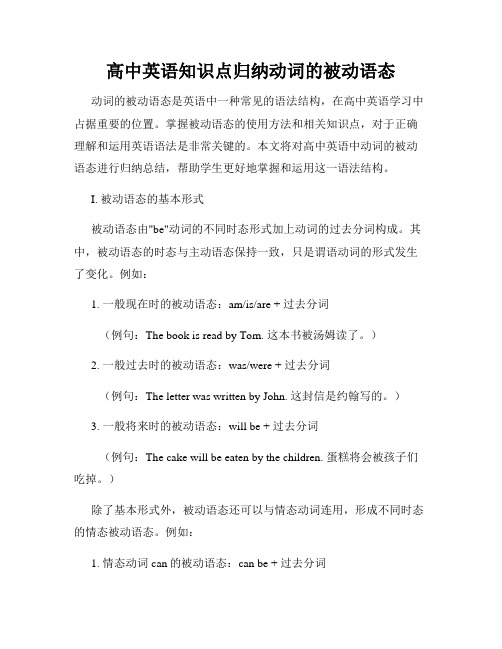
高中英语知识点归纳动词的被动语态动词的被动语态是英语中一种常见的语法结构,在高中英语学习中占据重要的位置。
掌握被动语态的使用方法和相关知识点,对于正确理解和运用英语语法是非常关键的。
本文将对高中英语中动词的被动语态进行归纳总结,帮助学生更好地掌握和运用这一语法结构。
I. 被动语态的基本形式被动语态由"be"动词的不同时态形式加上动词的过去分词构成。
其中,被动语态的时态与主动语态保持一致,只是谓语动词的形式发生了变化。
例如:1. 一般现在时的被动语态:am/is/are + 过去分词(例句:The book is read by Tom. 这本书被汤姆读了。
)2. 一般过去时的被动语态:was/were + 过去分词(例句:The letter was written by John. 这封信是约翰写的。
)3. 一般将来时的被动语态:will be + 过去分词(例句:The cake will be eaten by the children. 蛋糕将会被孩子们吃掉。
)除了基本形式外,被动语态还可以与情态动词连用,形成不同时态的情态被动语态。
例如:1. 情态动词can的被动语态:can be + 过去分词(例句:The problem can be solved by the teacher. 这个问题可以被老师解决。
)2. 情态动词should的被动语态:should be + 过去分词(例句:The car should be repaired by a professional mechanic. 这辆车应该由专业的机械师修理。
)II. 被动语态的用法1. 当我们不知道或不关心动作的执行者时,可以使用被动语态。
例如:(例句:The vase was broken. 这个花瓶被打破了。
)2. 当动作的承受者比执行者更重要或更值得强调时,可以使用被动语态。
例如:(例句:The cake was made by my grandmother.这个蛋糕是我奶奶做的。
高中十种时态及被动语态
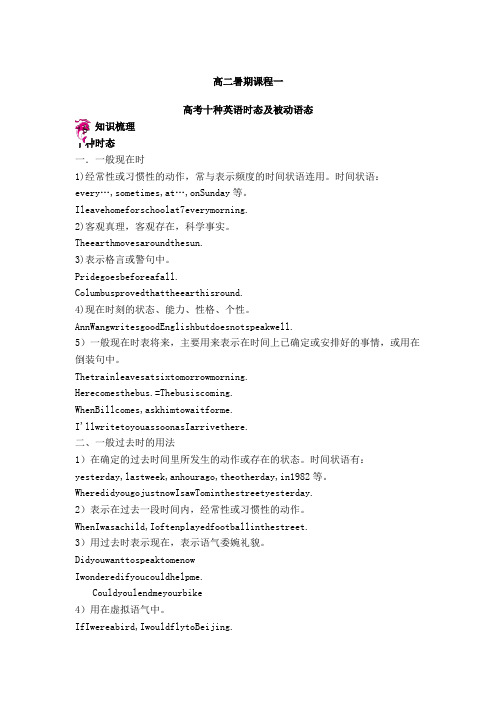
高二暑期课程一高考十种英语时态及被动语态知识梳理十种时态一.一般现在时1)经常性或习惯性的动作,常与表示频度的时间状语连用。
时间状语:every…,sometimes,at…,onSunday等。
Ileavehomeforschoolat7everymorning.2)客观真理,客观存在,科学事实。
Theearthmovesaroundthesun.3)表示格言或警句中。
Pridegoesbeforeafall.Columbusprovedthattheearthisround.4)现在时刻的状态、能力、性格、个性。
AnnWangwritesgoodEnglishbutdoesnotspeakwell.5)一般现在时表将来,主要用来表示在时间上已确定或安排好的事情,或用在倒装句中。
Thetrainleavesatsixtomorrowmorning.Herecomesthebus.=Thebusiscoming.WhenBillcomes,askhimtowaitforme.I'llwritetoyouassoonasIarrivethere.二、一般过去时的用法1)在确定的过去时间里所发生的动作或存在的状态。
时间状语有:yesterday,lastweek,anhourago,theotherday,in1982等。
WheredidyougojustnowIsawTominthestreetyesterday.2)表示在过去一段时间内,经常性或习惯性的动作。
WhenIwasachild,Ioftenplayedfootballinthestreet.3)用过去时表示现在,表示语气委婉礼貌。
DidyouwanttospeaktomenowIwonderedifyoucouldhelpme.Couldyoulendmeyourbike4)用在虚拟语气中。
IfIwereabird,IwouldflytoBeijing.特殊句式◎Itistimeforsb.todosth“到……时间了;该……了”,Itistimesb.didsth.“时间已迟了;早该……了”,例如:Itistimeforyoutogotobed.你该睡觉了。
高中英语被动语态知识点总结
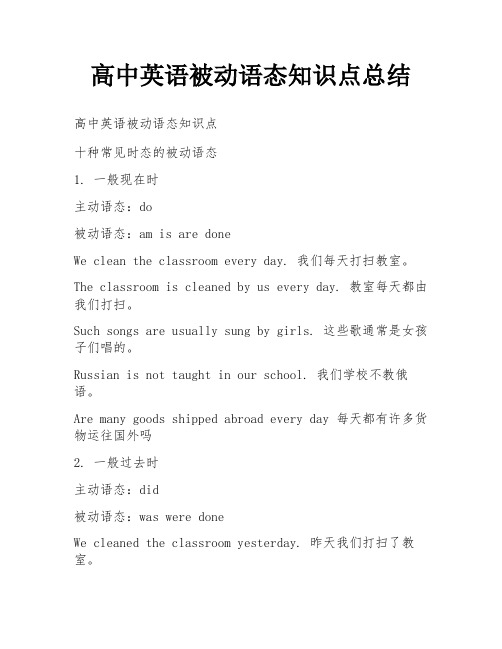
高中英语被动语态知识点总结高中英语被动语态知识点十种常见时态的被动语态1. 一般现在时主动语态:do被动语态:am is are doneWe clean the classroom every day. 我们每天打扫教室。
The classroom is cleaned by us every day. 教室每天都由我们打扫。
Such songs are usually sung by girls. 这些歌通常是女孩子们唱的。
Russian is not taught in our school. 我们学校不教俄语。
Are many goods shipped abroad every day 每天都有许多货物运往国外吗2. 一般过去时主动语态:did被动语态:was were doneWe cleaned the classroom yesterday. 昨天我们打扫了教室。
The classroom was cleaned by us yesterday. 昨天教室被我们打扫了。
The window was broken by my son. 窗子是我儿子打破的。
Were many trees planted on the hill yesterday 昨天山上种了许多树吗?How much money was stolen in all 一共被偷了多少钱?3. 一般将来时主动语态:will shall do被动语态:will shall be doneWe will clean the classroom soon. 我们很快要打扫教室。
The classroom will be cleaned soon. 教室很快要被打扫了。
The work will be done immediately. 这工作将马上做。
Will the school sports meeting be held next week? 校运动会将在下星期举行吗?When shall we be given a lecture on the Internet 什么时候给我们作有关因特网的讲座?4. 一般过去将来时主动语态:would do被动语态:would be doneWe told him that we would clean the classroom soon. 我们告诉他我们马上就打扫教室。
(完整)高中英语语法(时态和语态)

高中英语语法(时态和语态)一.动词的时态时态是谓语动词所表示的动作或情况发生时间的各种形式。
英语动词有16种时态,但是常见的只有九种:一般现在时、一般过去时、一般将来时、现在进行时、过去进行时、现在完成时、过去完成时、过去将来时、现在完成进行时。
(一)一般现在时(do / does)1.具体用法1) 表示经常性或习惯性动作We always care for each other and help each other. 我们总是互相关心互相帮助。
He goes to school every day.2)表示现在的特征或状态He is very happy.Do you sing? ----A little.3)表示普遍真理Light travels faster than sound. 光速比声速快。
Actions speak louder than words. 行动胜过言语。
* 常与一般现在时态连用的词或短语主要有:often, usually, sometimes, every day,every morning/afternoon, on Sundays/weekends等等。
I often go to the cinema on Sundays. 我经常星期天去看电影。
He goes to work early every day. 他每天上班很早。
(二)一般过去时( did )(1)表示过去某一特定时间所发生的、可完成的动作或状态,常与表示确切过去时间的词、短语或从句连用。
例如:We went to the pictures last night and saw a very interesting film.(2)表示过去习惯性动作。
例如:He always went to class last.I used to do my homework in the library.(三)一般将来时( will / shall do)1)表示将来打算进行或期待发生的动作或状态。
高中语法复习动词时态与语态
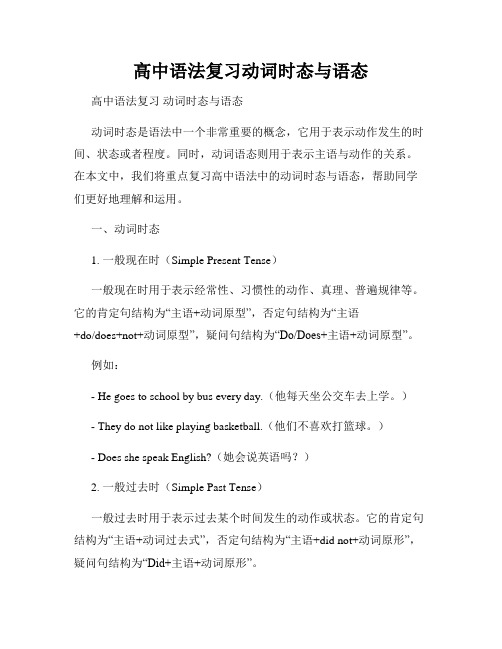
高中语法复习动词时态与语态高中语法复习动词时态与语态动词时态是语法中一个非常重要的概念,它用于表示动作发生的时间、状态或者程度。
同时,动词语态则用于表示主语与动作的关系。
在本文中,我们将重点复习高中语法中的动词时态与语态,帮助同学们更好地理解和运用。
一、动词时态1. 一般现在时(Simple Present Tense)一般现在时用于表示经常性、习惯性的动作、真理、普遍规律等。
它的肯定句结构为“主语+动词原型”,否定句结构为“主语+do/does+not+动词原型”,疑问句结构为“Do/Does+主语+动词原型”。
例如:- He goes to school by bus every day.(他每天坐公交车去上学。
)- They do not like playing basketball.(他们不喜欢打篮球。
)- Does she speak English?(她会说英语吗?)2. 一般过去时(Simple Past Tense)一般过去时用于表示过去某个时间发生的动作或状态。
它的肯定句结构为“主语+动词过去式”,否定句结构为“主语+did not+动词原形”,疑问句结构为“Did+主语+动词原形”。
例如:- I watched a movie last night.(昨晚我看了一场电影。
)- They did not go to the party.(他们没有参加派对。
)- Did you finish your homework?(你完成作业了吗?)3. 一般将来时(Simple Future Tense)一般将来时用于表示将来某个时间会发生的动作或状态。
它的肯定句结构为“主语+will+动词原形”,否定句结构为“主语+will not+动词原形”,疑问句结构为“Will+主语+动词原形”。
例如:- She will go to Beijing next week.(她下周将去北京。
)- We will not have a meeting tomorrow.(明天我们不开会。
高考英语基础语法:动词时态与被动语态详解
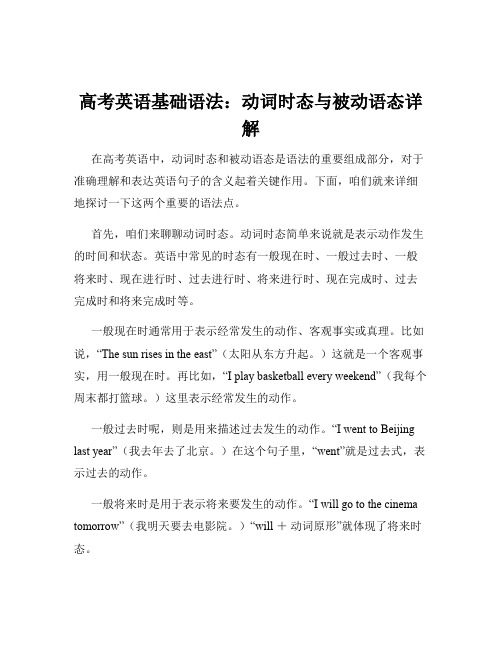
高考英语基础语法:动词时态与被动语态详解在高考英语中,动词时态和被动语态是语法的重要组成部分,对于准确理解和表达英语句子的含义起着关键作用。
下面,咱们就来详细地探讨一下这两个重要的语法点。
首先,咱们来聊聊动词时态。
动词时态简单来说就是表示动作发生的时间和状态。
英语中常见的时态有一般现在时、一般过去时、一般将来时、现在进行时、过去进行时、将来进行时、现在完成时、过去完成时和将来完成时等。
一般现在时通常用于表示经常发生的动作、客观事实或真理。
比如说,“The sun rises in the east”(太阳从东方升起。
)这就是一个客观事实,用一般现在时。
再比如,“I play basketball every weekend”(我每个周末都打篮球。
)这里表示经常发生的动作。
一般过去时呢,则是用来描述过去发生的动作。
“I went to Beijing last year”(我去年去了北京。
)在这个句子里,“went”就是过去式,表示过去的动作。
一般将来时是用于表示将来要发生的动作。
“I will go to the cinema tomorrow”(我明天要去电影院。
)“will +动词原形”就体现了将来时态。
现在进行时表示正在进行的动作。
“I am reading a book now”(我现在正在读书。
)“be +动词的现在分词”构成现在进行时。
过去进行时用于描述过去某个时刻正在进行的动作。
“I was watching TV at 8 o'clock yesterday evening”(昨天晚上 8 点我正在看电视。
)将来进行时相对用得少一些,它表示将来某个时刻正在进行的动作。
比如,“This time next week, I will be having a meeting”(下周这个时候,我将正在开会。
)现在完成时表示过去发生的动作对现在造成的影响或结果。
“I have finished my homework”(我已经完成了作业。
高中英语语法(大全)
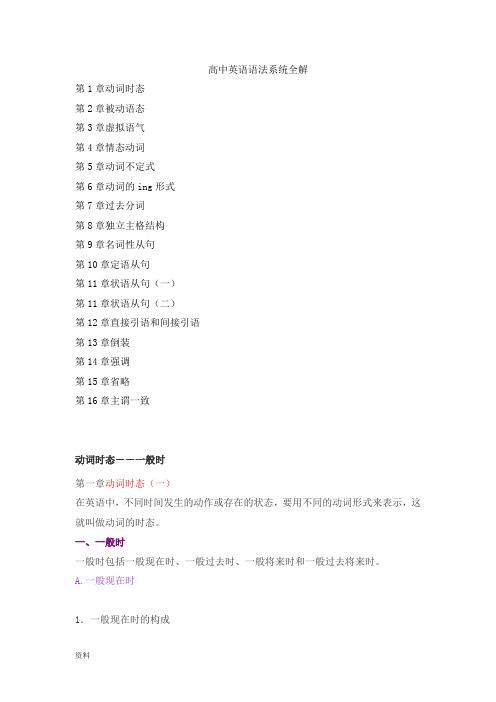
高中英语语法系统全解第1章动词时态第2章被动语态第3章虚拟语气第4章情态动词第5章动词不定式第6章动词的ing形式第7章过去分词第8章独立主格结构第9章名词性从句第10章定语从句第11章状语从句(一)第11章状语从句(二)第12章直接引语和间接引语第13章倒装第14章强调第15章省略第16章主谓一致动词时态--一般时第一章动词时态(一)在英语中,不同时间发生的动作或存在的状态,要用不同的动词形式来表示,这就叫做动词的时态。
一、一般时一般时包括一般现在时、一般过去时、一般将来时和一般过去将来时。
A.一般现在时1.一般现在时的构成一般现在时主要用动词原形来表示。
主语是第三人称单数时,动词后面要加-s 或-es。
They want good jobs.他们想要好的工作。
The coat matches the dress.外衣和裙子很相配。
This work does not satisfy me.这项工作我不满意。
Do you understand?你懂了吗?2.一般现在时的用法①一般现在时的基本用法a.表示现在习惯性的动作或存在状态He always takes a walk after supper.晚饭后他总是散散步。
Everyone is in high spirits now.现在大家都情绪高涨。
b.表示客观事实或普遍真理The sun rises in the east and sets in the west.太阳从东方升起在西方落下。
Sound travels faster through water than it does through air.声音在水中的传播速度要比在空气中快。
Time and tide wait for no man.时间不等人。
c.表示主语的特征、能力和状态This cloth feels soft.这布摸上去很软。
I love classical music.我喜欢古典音乐。
动词时态和被动语态用法详细全面归纳总结
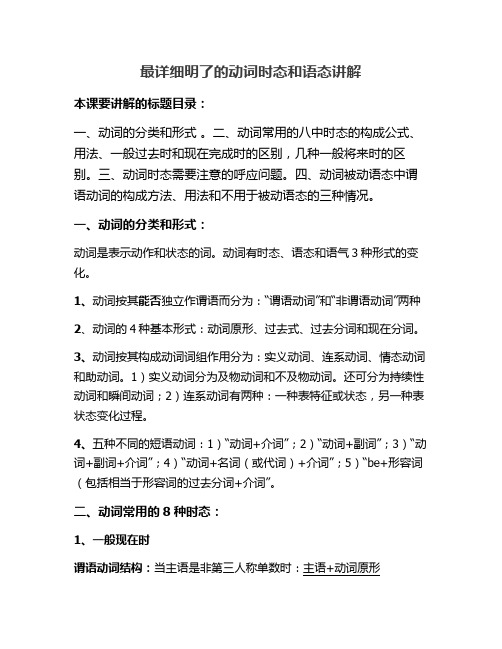
最详细明了的动词时态和语态讲解本课要讲解的标题目录:一、动词的分类和形式。
二、动词常用的八中时态的构成公式、用法、一般过去时和现在完成时的区别,几种一般将来时的区别。
三、动词时态需要注意的呼应问题。
四、动词被动语态中谓语动词的构成方法、用法和不用于被动语态的三种情况。
一、动词的分类和形式:动词是表示动作和状态的词。
动词有时态、语态和语气3种形式的变化。
1、动词按其能否独立作谓语而分为:“谓语动词”和“非谓语动词”两种2、动词的4种基本形式:动词原形、过去式、过去分词和现在分词。
3、动词按其构成动词词组作用分为:实义动词、连系动词、情态动词和助动词。
1)实义动词分为及物动词和不及物动词。
还可分为持续性动词和瞬间动词;2)连系动词有两种:一种表特征或状态,另一种表状态变化过程。
4、五种不同的短语动词:1)“动词+介词”;2)“动词+副词”;3)“动词+副词+介词”;4)“动词+名词(或代词)+介词”;5)“be+形容词(包括相当于形容词的过去分词+介词”。
二、动词常用的8种时态:1、一般现在时谓语动词结构:当主语是非第三人称单数时:主语+动词原形当主语是第三人称单数时:主语+动词的第三人称单数形式(动词的词尾要加-S)(规则:一般的动词词尾+S.以sh/ch/s/x结尾的词+es.以辅音字母Y结尾的把Y变成i,+es.辅音字母+o结尾的+es.) 。
一般现在时的用法:1)表示现在的习惯,经常发生的动作或存在的状态。
如:I often get up early in the morning .He likes reading in the afternoon.2)表示客观事实或真理及自然现象,此用法即使出现在过去语境中,也用一般现在时态。
如:The sun rises in the east.3)用于here,there开头的倒装句中,一般现在时表示正在发生的动作或存在的状态。
如:There goes the bell. Here comes the bus.2、一般过去时态谓语动词构成:主语+动词的过去式动词的过去式是在动词原形的基础上变化而来的,一般是在词尾加上ed.动词的过去式可分为规则动词和不规则动词.规则动词的过去式变化如下:一般情况下,动词词尾加 -ed ,如: work-ed, play-ed ,want-ed. Act-ed 等词。
高中英语被动语态讲解精华版
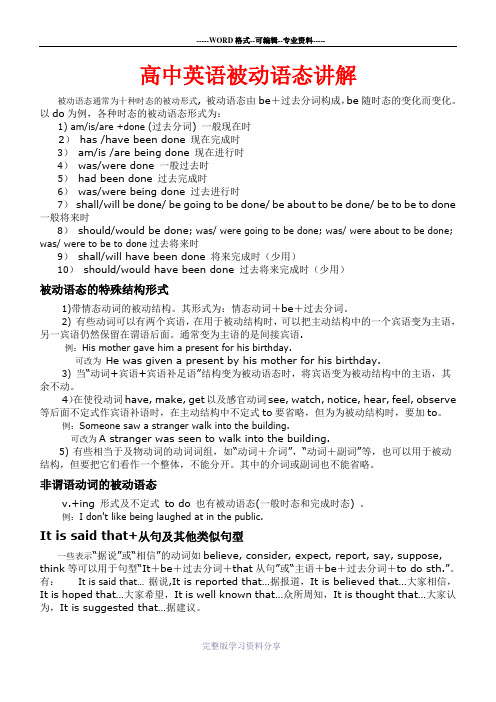
高中英语被动语态讲解被动语态通常为十种时态的被动形式, 被动语态由be+过去分词构成,be随时态的变化而变化。
以do为例,各种时态的被动语态形式为:1) am/is/are +done (过去分词) 一般现在时2)has /have been done 现在完成时3)am/is /are being done 现在进行时4)was/were done 一般过去时5)had been done 过去完成时6)was/were being done 过去进行时7)shall/will be done/ be going to be done/ be about to be done/ be to be to done 一般将来时8)should/would be done; was/ were going to be done; was/ were about to be done; was/ were to be to done过去将来时9)shall/will have been done 将来完成时(少用)10)should/would have been done 过去将来完成时(少用)被动语态的特殊结构形式1)带情态动词的被动结构。
其形式为:情态动词+be+过去分词。
2) 有些动词可以有两个宾语,在用于被动结构时,可以把主动结构中的一个宾语变为主语,另一宾语仍然保留在谓语后面。
通常变为主语的是间接宾语.例:His mother gave him a present for his birthday.可改为He was given a present by his mother for his birthday.3) 当“动词+宾语+宾语补足语”结构变为被动语态时,将宾语变为被动结构中的主语,其余不动。
4)在使役动词have, make, get以及感官动词see, watch, notice, hear, feel, observe 等后面不定式作宾语补语时,在主动结构中不定式to要省略,但为为被动结构时,要加to。
英语16大时态和8种被动语态
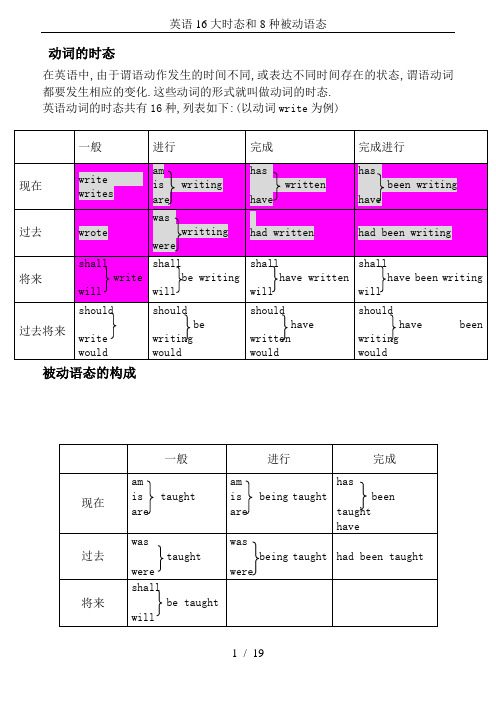
动词的时态在英语中,由于谓语动作发生的时间不同,或表达不同时间存在的状态,谓语动词都要发生相应的变化.这些动词的形式就叫做动词的时态.英语动词的时态共有16种,列表如下:(以动词write 为例)被动语态的构成一般 进行 完成 完成进行 现在 write writes am is writing arehas writtenhave has been writing have 过去wrote waswrittingwere had written had been writing 将来 shall write will shall be writing will shall have written will shall have been writingwill过去将来 should write wouldshouldbewritingwould should have written would should have been writing would 一般进行 完成 现在amis taughtare am is being taught are has been taught have 过去was taught were was being taught were had been taught 将来 shall be taught will被动语态由助动词be 加过去分词构成,时态通过be 表现出来.构成被动语态的一般疑问句时,须将第一个助动词移至主语之前,构成被动语态的否定句时,助动词后须加not. 各个时态的被动形式列表如下:(以动词teach 为例)英语被动语态讲解(一)语态的基本概念和种类语态是动词的一种形式,用来表明主语与谓语动词之间的关系。
所以英语的语态是通过动词形式的变化表现出来的。
语态有两种:主动语态和被动语态。
主语是动作的发出者为主动语态;主语是动作的接受者为被动语态。
2024年新高考版英语专题七谓语动词的时态和被动语态 讲解部分

3)表示客观事实、普遍真理或格言等。 例句 Light travels faster than sound. 光比声音传播得快。 Magellan proved that the earth is round. 麦哲伦证实地球是圆的。 4)表示将来。 ①在时间状语从句、条件状语从句或让步状语从句中。 例句 Even if we achieve great success in our studies, we will not be conceited. 即使我们在学习上取得很大成功,我们也不会自大的。(让步状语从句)
温馨提示 常与一般现在时连用的状语有often, always, usually, sometimes, every day, occasionally, never, seldom, generally, rarely, once a week, at weekends, on Sundays等。 2)表示现在的特征、能力、性格等。 例句 This job calls for great patience. 这份工作需要极大的耐心。 We are very busy these days. 这些天我们很忙。
2)be doing可用来表示计划、安排好要采取的动作或要做的事情,常与表 将来的时间状语连用。 例句 We're leaving early tomorrow morning. 我们明天一早就出发。 3)一般现在时可以表示按规定、计划或时间表要发生的事;在条件、时 间、让步状语从句中可用一般现在时表将来。 例句 According to the timetable, we have no classes tomorrow. 根据时间安排,明天我们不上课。 I'll write to her when I have time. 我有空会给她写信。
高中英语语法——被动语态用法归纳
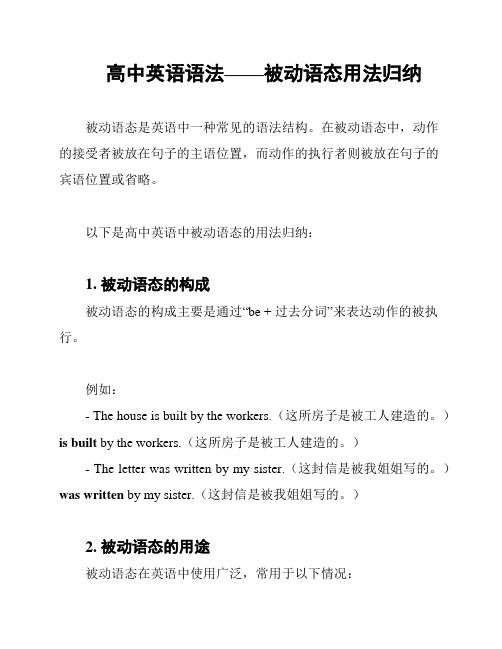
高中英语语法——被动语态用法归纳被动语态是英语中一种常见的语法结构。
在被动语态中,动作的接受者被放在句子的主语位置,而动作的执行者则被放在句子的宾语位置或省略。
以下是高中英语中被动语态的用法归纳:1. 被动语态的构成被动语态的构成主要是通过“be + 过去分词”来表达动作的被执行。
例如:- The house is built by the workers.(这所房子是被工人建造的。
)is built by the workers.(这所房子是被工人建造的。
)- The letter was written by my sister.(这封信是被我姐姐写的。
)was written by my sister.(这封信是被我姐姐写的。
)2. 被动语态的用途被动语态在英语中使用广泛,常用于以下情况:- 当动作的执行者不明确或不重要时。
例如:- The cake was eaten.(这个蛋糕被吃了。
)(动作的执行者不明确)was eaten.(这个蛋糕被吃了。
)(动作的执行者不明确)- The book is written in English.(这本书是用英语写的。
)(动作的执行者不重要)is written in English.(这本书是用英语写的。
)(动作的执行者不重要)- 当强调动作的接受者或结果时。
例如:- The city was destroyed by the earthquake.(这个城市被地震摧毁了。
)(强调结果)was destroyed by the earthquake.(这个城市被地震摧毁了。
)(强调结果)- The painting was done by a famous artist.(这幅画是由一位著名艺术家完成的。
)(强调接受者)was done by a famous artist.(这幅画是由一位著名艺术家完成的。
)(强调接受者)3. 被动语态与时态被动语态使用与相应时态的被动形式。
高中英语知识点归纳动词的完成被动语态
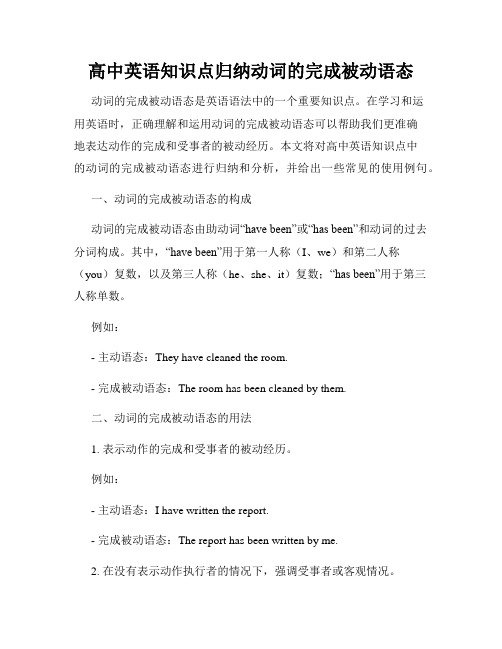
高中英语知识点归纳动词的完成被动语态动词的完成被动语态是英语语法中的一个重要知识点。
在学习和运用英语时,正确理解和运用动词的完成被动语态可以帮助我们更准确地表达动作的完成和受事者的被动经历。
本文将对高中英语知识点中的动词的完成被动语态进行归纳和分析,并给出一些常见的使用例句。
一、动词的完成被动语态的构成动词的完成被动语态由助动词“have been”或“has been”和动词的过去分词构成。
其中,“have been”用于第一人称(I、we)和第二人称(you)复数,以及第三人称(he、she、it)复数;“has been”用于第三人称单数。
例如:- 主动语态:They have cleaned the room.- 完成被动语态:The room has been cleaned by them.二、动词的完成被动语态的用法1. 表示动作的完成和受事者的被动经历。
例如:- 主动语态:I have written the report.- 完成被动语态:The report has been written by me.2. 在没有表示动作执行者的情况下,强调受事者或客观情况。
例如:- 主动语态:Someone has stolen my phone.- 完成被动语态:My phone has been stolen.3. 在需要使用被动语态的句型中。
例如:- 主动语态:They have received the invitation.- 完成被动语态:The invitation has been received by them.三、动词的完成被动语态常见的时态和语态转换1. 一般现在时- 主动语态:We have cleaned the house.- 完成被动语态:The house has been cleaned by us.2. 一般过去时- 主动语态:He had finished his homework.- 完成被动语态:His homework had been finished by him.3. 一般将来时- 主动语态:They will have completed the project.- 完成被动语态:The project will have been completed by them.4. 现在进行时- 主动语态:She has been painting the wall.- 完成被动语态:The wall has been being painted by her.5. 过去进行时- 主动语态:They had been repairing the car.- 完成被动语态:The car had been being repaired by them.6. 现在完成时- 主动语态:We have planted the trees.- 完成被动语态:The trees have been planted by us.7. 过去完成时- 主动语态:He had written the letter.- 完成被动语态:The letter had been written by him.四、注意事项1. 动词的完成被动语态要根据不同的主语的数量和人称变化。
- 1、下载文档前请自行甄别文档内容的完整性,平台不提供额外的编辑、内容补充、找答案等附加服务。
- 2、"仅部分预览"的文档,不可在线预览部分如存在完整性等问题,可反馈申请退款(可完整预览的文档不适用该条件!)。
- 3、如文档侵犯您的权益,请联系客服反馈,我们会尽快为您处理(人工客服工作时间:9:00-18:30)。
高中英语动词的时态与语态动词的时态时态的构成形式列表:一、一般现在时1)表示经常性或习惯性的动作,常与表示频度的时间状语连用。
时间状语:every…, sometimes,at…, on Sunday。
例如:I leave home for school at 7 every morning.2)客观真理,客观存在,科学事实。
例如:The earth moves around the sun.3)表示格言或警句。
例如:Pride goes before a fall.﹝骄者必败。
﹞注意:此用法如果出现在宾语从句中,即使主句是过去时,从句谓语也要用一般现在时。
例:Columbus proved that the earth is round.4)现在时刻的状态、能力、性格、个性。
例如:I don't want so much.。
Ann writes good English but does not speak well.比较:Now I put the sugar in the cup. 把糖放入杯子。
I am doing my homework now. 我正在做功课。
第一句用一般现在时,用于操作演示或指导说明的示范性动作,表示言行的瞬间动作。
第二句中的now是进行时的标志,表示正在进行的动作的客观状况,所以后句用一般现在时。
二、一般过去时1)在确定的过去时间里所发生的动作或存在的状态。
例如:时间状语有:yesterday, last week, an hour ago, the other day, in 1982等。
例如:Where did you go just now?2)表示在过去一段时间内,经常性或习惯性的动作。
例如:When I was a child, I often played football in the street.Whenever the Browns went during their visit, they were given a warm welcome.3)句型:It is time for sb. to do sth"到……时间了""该……了"。
例如:It is time for you to go to bed.It is time that sb. did sth. "时间已迟了""早该……了" ,例如It is time you went to bed.你早该睡觉了。
would (had)rather sb. did sth.表示'宁愿某人做某事'。
例如:I'd rather you came tomorrow.4)wish, wonder, think, hope 等用过去时,作试探性的询问、请求、建议等,而一般过去时表示的动作或状态都已成为过去,现已不复存在。
例如:I thought you might have some.比较:Christine was an invalid all her life.(含义:她已不在人间。
)Christine has been an invalid all her life.(含义:她现在还活着)Mrs. Darby lived in Kentucky for seven years. (含义:达比太太已不再住在肯塔基州。
)Mrs. Darby has lived in Kentucky for seven years. (含义:现在还住在肯塔基州,有可能指刚离去)注意:用过去时表示现在,表示委婉语气。
1)动词want, hope, wonder, think, intend 等。
例如:Did you want anything else?I wondered if you could help me.2)情态动词could, would。
例如:Could you lend me your bike?典型例题---- Your phone number again? I ___ quite catch it.---- It's 69568442.A. didn'tB. couldn'tC. don'tD. can't答案A. 本句虽没有明确的时间状语,但从语意上看出,在听的时候没有听懂这个动作发生在过去,因此应用过去时。
三、一般将来时1)shall用于第一人称,常被will 所代替。
will 在陈述句中用于各人称,在征求意见时常用于第二人称。
例如:Which paragraph shall I read first?Will you be at home at seven this evening?2)be going to +不定式,表示将来。
a. 主语的意图,即将做某事。
例如:What are you going to do tomorrow?b. 计划,安排要发生的事。
例如:The play is going to be produced next month。
c. 有迹象要发生的事。
例如:Look at the dark clouds, there is going to be a storm.3)be +不定式表将来,按计划或正式安排将发生的事。
例如:We are to discuss the report next Saturday.4)be about to +不定式,意为马上做某事。
例如:He is about to leave for Beijing.注意:be about to do 不能与tomorrow, next week 等表示明确将来时的时间状语连用。
一般现在时表将来1)下列动词come, go, arrive, leave, start, begin, return的一般现在时可以表示将来,主要用来表示在时间上已确定或安排好的事情。
例如:The train leaves at six tomorrow morning.When does the bus star? It stars in ten minutes.2)以here, there等开始的倒装句,表示动作正在进行。
例如:Here comes the bus. = The bus is coming.There goes the bell. = The bell is ringing.3)在时间或条件句中。
例如:When Bill comes (不是will come), ask him to wait for me.I'll write to you as soon as I arrive there.4)在动词hope, take care that, make sure that等的宾语从句中。
例如:I hope they have a nice time next week.Make sure that the windows are closed before you leave the room.用现在进行时表示将来下列动词come, go, arrive, leave, start, begin, return等现在进行时可以表示将来。
例如:I'm leaving tomorrow.Are you staying here till next week?四、一般现在完成时现在完成时用来表示过去发生的对现在有影响的动作或状态,也可表示过去某时间开始,一直持续到现在的动作或状态。
其构成:have (has)+过去分词。
I have been to shanghai.He has n’t given me any more trouble since then.比较一般过去时与现在完成时1)一般过去时表示过去某时发生的动作或单纯叙述过去的事情,强调动作;现在完成时为过去发生的,强调过去的事情对现在的影响,强调的是影响。
2)一般过去时常与具体的时间状语连用,而现在完成时通常与模糊的时间状语连用,或无时间状语。
一般过去时的时间状语:yesterday, last week,…ago, in1980, in October, just now 等,皆为具体的时间状语。
现在完成时的时间状语:for, since, so far, ever, never, just, yet, till/until, up to now, in past years, always等,皆不确定的时间状语。
共同的时间状语:this morning, tonight, this April, now, already, recently, lately 等。
3)现在完成时可表示持续到现在的动作或状态,动词一般是延续性的,如live, teach, learn, work, study, know.。
一般过去时常用的非持续性动词有come, go, leave, start, die, finish, become, get married等。
例如:I saw this film yesterday. (强调看的动作发生过了)I have seen this film. (强调对现在的影响,电影的内容已经知道了)Why did you get up so early? (强调起床的动作已发生过了)Who hasn't handed in his paper? (强调有卷子未交,疑为不公平竞争)He has been in the League for three years. (在团内的状态可延续)He has been a League member for three years. (是团员的状态可持续)句子中如有过去时的时间副词(如yesterday, last, week, in 1960)时,不能使用现在完成时,要用过去时。
(错)Tom has written a letter to his parents last night.(对)Tom wrote a letter to his parents last night.用于现在完成时的句型1)It is the first / second time.... that…结构中的从句部分,用现在完成时。
例如:It is the first time that I have visited the city.This is the first time (that)I've heard him sing.注意:It was the third time that the boy had been late.2)This is +形容词最高级+that…结构,that 从句要用现在完成时。
